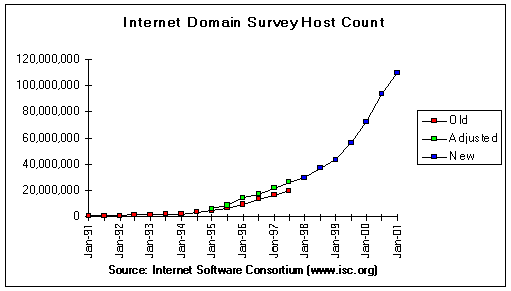 |
|
[ web
trends | pubs | textbook | Web
Develop | engine submission
]
Growth of the Internet and the Web
The bursting of the Stock Market Dot Com
Bubble in late 2000 and early 2001 is healthy for the future
of the Web and the Internet. The technology continues to change the
way people communicate, work, and play. The true nature and
potential of the information revolution is now better
understood by more people and that can only be good for the
future.
According to Newsweek (September 20
1999):
``Worldwide there are almost 200 million people on the
Internet. In the United States alone, 80 million... A third of
wired Americans now do at least some of their shopping on the
Net... By 2003 more than 500 million people will be surfing the
Web.... Americans with Net access spend an average of 8.8 hours a
week online. News sites are the most popular; then travel, weather,
music and technology.... Half of all adults now have access to the
Internet either at home or at work... By the end of last year, more
than 36 million Americans were getting [encode] [clear]news at
least once a week from the Internet.... 46% of Americans send or
receive e-mail every day. In addition, as many as 476 million
instant messages are sent daily by AOL's 43 million registered
users.... Worldwide, 225 million people can send and receive
e-mail... Fifty one percent of American classrooms had Internet
connections last year.''
In the US, it took radio 38 years, and TV 13
years, to reach an audience of 50 million. But, according to the
Pittsburgh Post Gazette (Vol. 71, no. 259, 4/16/98), ``The
number of Web users in the US has reached 50 million in just four
years''. In 1998, China already has more than a million Internet
users (CPSR Newsletter, Fall, 1998, 16(4), p. 16). All indications
are that Web usage will increase rapidly in the US, and even more
so in China.

Data from the Internet Software
Consortium show that, in January 2001, the number of IP
addresses with a host name (the number of computers on the
Internet) has reached 109,574,429. The preceding figure shows the
host count in the past few years. The survey method has changed in
1997 from counting domain names to counting IP addresses with
assigned domain names---a more accurate count to be
sure.
Use of the Internet and the Web
According to Technology: The Small Business
Edge (Newsweek, March 31, 1997, after p. 46)
``More than 99 percent of US employers are small businesses,
and they employ nearly 60 percent of the private sector workforce.
Small businesses generate 54 percent of U.S. sales and 40 percent
of the Gross Domestic Product, and they account for 42 percent of
private sector business net worth...53 percent of small businesses
plan to be selling on the Internet within five years...93 percent
of small businesses believe that the most important use of a PC is
to save time... Already, one out of 10 small businesses advertises
on the Internet, and the number is expected to triple before the
end of this year. This is because Web advertising works: over
two-thirds of Web advertisers studied by Forrester Research last
fall said their advertising has been
successful.''
In the US, more than 8 in 10 families purchase
PCs for `children's educational use' and almost every PC is used to
access the Internet and the Web. And, as of the end of 1999, more
than 50 percent of high schools are connected to the Internet and
Web.
These and much more easily obtained data show
that most businesses, educational institutions, and government
offices need to establish and maintain sites on the Web. And the
number of sites and pages are increasing at a rapid
rate.
|
 |
|